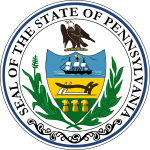| |||||||||||||||||||
All 13 Pennsylvania seats to the United States House of Representatives | |||||||||||||||||||
|---|---|---|---|---|---|---|---|---|---|---|---|---|---|---|---|---|---|---|---|
| |||||||||||||||||||
Elections to the United States House of Representatives were held in Pennsylvania on October 14, 1800, for the 7th Congress.
Background
Thirteen Representatives (8 Democratic-Republicans and 7 Federalists) had been elected in the previous election
Congressional districts
Pennsylvania was divided into 12 districts, one of which (the 4th) was a plural district, with 2 Representatives. This was the last election which used these districts.
- The 1st district consisted of the City of Philadelphia
- The 2nd district consisted of Philadelphia County
- The 3rd district consisted of Chester and Delaware Counties
- The 4th district (2 seats) consisted of Montgomery, Bucks and Northampton Counties
- The 5th district consisted of Berks and Luzerne County
- The 6th district consisted of Northumberland and Dauphin Counties
- The 7th district consisted of Lancaster County
- The 8th district consisted of York County
- The 9th district consisted of Mifflin and Cumberland County
- The 10th district consisted of Bedford, Huntingdon and Franklin Counties
- The 11th district consisted of Westmoreland and Fayette Counties
- The 12th district consisted of Allegheny and Washington Counties
The counties that made up the 5th district did not border each other. That district was therefore made up of two separate pieces rather than being a single contiguous entity
Note: Many of these counties covered much larger areas than they do today, having since been divided into smaller counties
Election results
Nine incumbents (8 Democratic-Republicans and 1 Federalist) ran for re-election, all of whom won re-election. The incumbents Robert Waln (F) of the 1st district, Richard Thomas (F) of the 3rd district, John W. Kittera (F) of the 7th district and Thomas Hartley (F) of the 8th district did not run for re-election. Ten Democratic-Republicans and three Federalists were elected, a net gain of 2 seats for the Democratic-Republicans.
| District | Democratic-Republican | Federalist | ||||
|---|---|---|---|---|---|---|
| 1st | William Jones | 1,698 | 50.2% | Francis Gurney | 1,684 | 48.8% |
| 2nd | Michael Leib (I) | 2,744 | 77.8% | John Lardner | 783 | 22.2% |
| 3rd | Joseph Shallcroft | 2,389 | 46.7% | Joseph Hemphill | 2,732 | 53.3% |
| 4th 2 seats |
Peter Muhlenberg (I) | 6,683 | 34.4% | Cadwallader C. Evans | 3,028 | 15.6% |
| Robert Brown (I) | 6,681 | 34.4% | John Arndt | 3,010 | 15.5% | |
| 5th | Joseph Hiester (I) | 3,018 | 83.2% | Roswell Wells | 611 | 16.8% |
| 6th | John A. Hanna (I) | 4,295 | 74.6% | Samuel Maclay | 1,460 | 25.4% |
| 7th | John Whitehill | 1,927 | 45.9% | Thomas Boude | 2,274 | 54.1% |
| 8th | John Stewart | 2,263 | 54.8% | John Eddie | 1,866 | 45.2% |
| 9th | Andrew Gregg (I) | 2,383 | 72.6% | David Mitchell | 901 | 27.4% |
| 10th | David Bard | 967 | 46.4% | Henry Woods (I) | 1,118 | 53.6% |
| 11th | John Smilie (I) | 2,182 | 100% | |||
| 12th | Albert Gallatin (I) | 4,270 | 72.9% | Presley Neville | 1,590 | 27.1% |
Special elections
There were three special elections following the October elections, one of which was for the outgoing Congress.
In the 4th district, Peter Muhlenberg (DR) was elected to the Senate on November 27, 1800, while in the 12th district, Albert Gallatin (DR) was appointed Secretary of the Treasury in May, 1801. Neither served in the 7th Congress, and special elections were held in both districts on October 13, 1801
| District | Democratic-Republican | Federalist Party | ||||
|---|---|---|---|---|---|---|
| 4th | Isaac Van Horne | 4,687 | 100% | |||
| 12th | William Hoge | 4,687 | 82.6% | Alexander Fowler | 836 | 14.7% |
| Isaac Weaver | 154 | 2.7% | ||||
References
- Electoral data are from the Wilkes University Election Statistics Project
- Also won special election to 6th Congress
| (1799←) 1800 United States elections (→1801) | |
|---|---|
| U.S. President | |
| U.S. Senate | |
| U.S. House | |
| Governors | |
| States and territories | |
